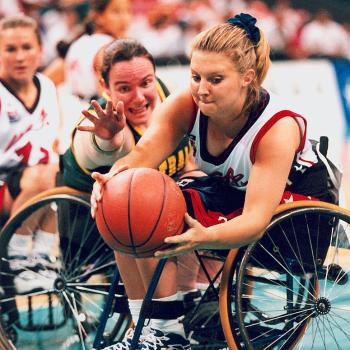This is a quick PSA based on some conversations trending at the moment, on the hazards of “Graded Exercise Therapy (GET).” Short version: If someone suggests you try this GET thing, fire them from your life.
So here is my favorite workout of late. I get on the ice, and I run sprints for an hour working hockey skills. I usually take two brief water breaks, during which my heart rate gets down to 140-150 and then I go back to it. The rest of the time, during the “rest” period between sprints my heart rate gets *down* to my theoretical max heart rate (220-age), and then I run a sprint which pops the HR back up about ten points over “max.”
I tell you this not as a recommendation (no! Seriously: NO!) but as essential background: I am not a person who dislikes exertion.
–> And also, obviously that approximate calculation of max heart rate is not my max heart rate. It’s a fluke of physiology, and neither here nor there, other than to make my one point: I am not shy about exerting myself.
Also: I am not a person who is ignorant of how to improve one’s fitness.
Regular readers will recall that during my bout of acute illness for two months last fall, my maximum sustainable daily activity level was about 5,000 steps a day, and that was with lying down almost the entirety of the day, and sleeping 10+ hours at night. Once that exacerbation resolved, I was easily up to 7,500 steps/day plus normal activity and sleep duration, which isn’t amazing except it was an immediate 50% increase in “fitness” level. That all came on the tail of a couple years of pretty rough going.
Since that time I’ve been fortunately free of all but a couple brief colds, and sure enough, persistent fitness training does what it does in a more-or-less healthy person.
So, again, my credentials: I got interested amateur athletics in the late 1980s and I’ve done what I can to enjoy a physically active life since then, but I also have gathered about a decade now of experience with relapsing and remitting chronic illness that at times makes exercise not possible.
As a result, I have experience with athletic training as a healthy-person working up from regular-Joe to competitive athlete and as a sick-person maintaining realistic activity levels during a prolonged illness and as someone coming out of a prolonged illness and rebuilding fitness.
I am here to tell you that “Graded Exercise Therapy” (GET) is an idea so horrible I can’t even believe people can recommend it with a straight face.
If you’re an athlete, or just a logical person, and you never heard of GET, you would probably guess it must mean something like this: Figure out what your baseline fitness level is, and then over time gradually increase your exercise as-able.
That’s the fundamental fact of fitness training. You can fine tune your training a million different ways, but it all boils down to the art of pushing yourself enough but not too much.
If you imagined “Graded Exercise Therapy” was this? You would be wrong.
What GET actually is: Overtraining.
The theory behind GET is that the targeted patients have a pyschological fear of exertion, and they need to be pushed past that point. Therefore they are instructed to increase their exertion on a scheduled basis regardless of how it makes them feel.
Patients who drop out of the training program because, whoah, turns out overtraining is bad for you and feels terrible? They get told they just don’t want to get better. They must want to be sick.
I was shocked when I learned that actual doctors who presumably went to medical school and everything somehow believe this is a good idea.
No. Part of your development as an athlete is learning to tell the difference between intense training and over-training. The difference between a good coach and a terrible coach is the ability to recognize that point when more of a good thing turns into a bad thing.
Overtraining will wreck anyone.
If you are sick? You definitely do not want to overtrain.
GET is literally an instruction to overtrain.
As an athlete, you prevent overtraining by paying attention to your body.
Stubbornly pushing yourself because that’s what the program says to do, with no regard for the impact your workouts are having on your body? That’s how you overtrain.
The momentum debunking GET has picked up, and major health agencies have started withdrawing their endorsement of this approach to treating fatigue-primary chronic illnesses. There’s a fair bit of dodging and redefining as well, in which clinicians may say they are using GET and it works great, but actually they are just doing a regular fitness program, where increases in training intensity or duration are matched to the individual’s actual fitness gains.
Okay whatever.
Except that by insisting that a regular, properly-designed exercise program is “GET” they are memory-holing the real problem of doctors and therapists designing harmful programs that literally were following the recipe for overtraining.
Again, I write all this as a person who is geuinely fond of intense exercise. It makes me happy. It feels good while I’m doing it, it feels good afterwards, and yeah I like to look at the little charts my fitness tracker generates and admire all that go-go-go.
But I write this as someone who feels good doing an hour of sprints. I’m not pushing myself despite myself. I am listening to by body and working within its capacity for work and recovery. I got to this point by building up my fitness bit by bit, starting sensibly and taking rest days as-needed.
I also got to this point after a lot of years of being unable to exercise when I wanted to, because I was sick. When you are sick you can’t do things you can do when you are healthy. That’s what being sick means.
What changed wasn’t a psychological state. I was never afraid of exercise. What changed was a physical state: I recovered (enough) from the illness that I could do more exercise. Yay!
And, in conclusion: You should do the amount of activity that is safe and healthy for you. That amount will vary over the course of your life. You have to learn how to be the expert in assessing what you can and can’t do.
But if an athletic trainer or heaven forbid a medical professional tries to talk you into overtraining? Fire them.
Photo: My skates back when they were fresh from the box. They’re broken in now and we like that much better. And yeah, they’re just sensible basic Mom skates. We aren’t the NHL here. We just like to zoom around and have fun.















